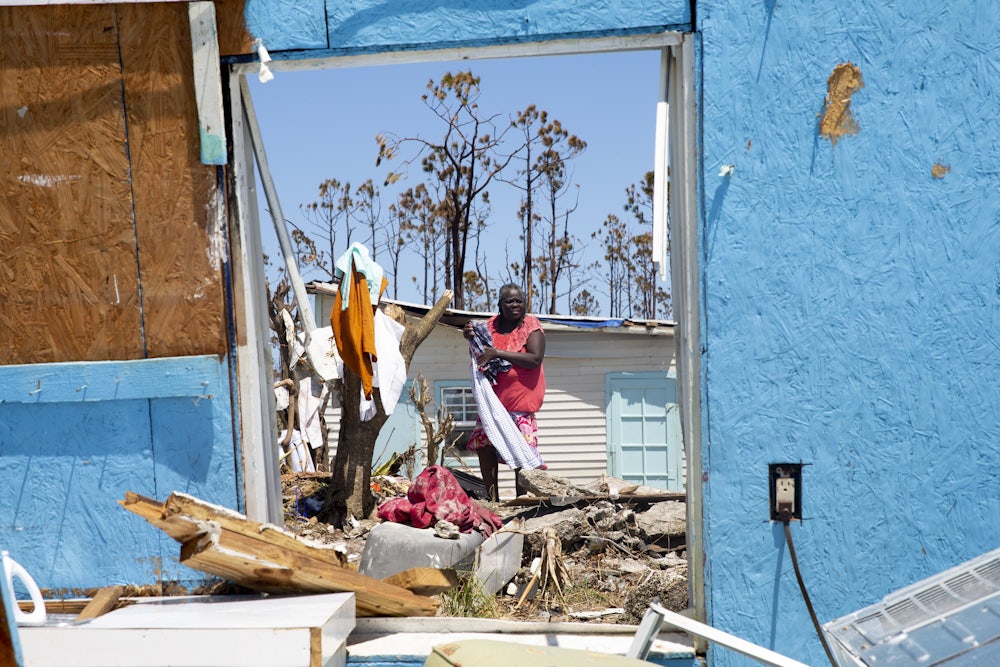Hurricane Dorian slammed into Grand Bahama island on September 1, 2019. The storm’s 200 mph winds and torrential rains stalled over the island for more than 40 hours as water levels rose 18 to 23 feet above normal. 70 people lost their lives, and property damages were estimated at about $8.28 billion.
As the president and visual producer of an online news site, Dave Mackey recorded the Category 5 hurricane as it pounded his home on Grand Bahama, battering trees and houses and tossing shipping containers as though they were toys. “The canal across my house was raging like an ocean,” he said. He wasn’t sure he and his wife would make it out alive.
Mackey had experienced and survived two hurricanes before—Jeanne, which hit the island in 1998, and Frances, which hit in 2004. “At that time, I lived in a beachside community, and left my house to stay with friends,” Mackey said. This time, “I chose to stay. I videotaped the hurricane and posted updates online and on social media.”
Mackey built his home to withstand extreme weather conditions with hurricane-resistant windows and doors. “The house is 20 feet up from the water level and it is built on 41 special pilings—heavy stakes to support the foundation instead of a concrete foundation that can crack during the flooding,” he said.
Across the canal, Mackey’s neighbors weren’t as lucky. They lived in a one-story house, which stood only five feet above water level—a new minimum standard set by the government to protect buildings from the impact of hurricanes.
“We had agreed to use walkie-talkies to communicate during the storm,” Mackey said. Eventually, the devices failed. “Last time I talked to them—the parents, their daughter, and five dogs had climbed onto their kitchen counter to escape the rising waters inside their house.”
Mackey saw the waters pull away his neighbors’ wall. Part of their roof ripped off, too. “In my panic, I thought they were gone, too,” he said. He didn’t know it, but the neighbors had managed to get out. “This happened just before the stormwater rose up to 20 feet and isolated our area from the bridge, which is the only way to get out from here.”
Once the waters swamped the bridge, Mackey was stranded in his house as the storm hovered over the island for three more days. “At one point, I saw the water only two steps away from our front door,” he said. “I knew that the high tide would come around 11 p.m. I kept paying attention to the water. Hours went by, the waves kept coming in, and finally, they started to recede. Only then I felt comfortable enough to go to bed.”
Mackey’s house lost electricity, the winds were so powerful that he couldn’t open his front door, and there was no running water. “My downstairs was totally flooded and destroyed,“ he says. “My ‘man cave’ with music gear, my speakers, my sound system and all of our tools, as well as one bathroom were all consumed by the storm.” But he felt safe—and lucky, compared to others.
He realized he could make use of the rainwater upstairs.
“My wife and I had water-collecting duty,” Mackey said. “We wiped off the rainwater with towels, squeezed the wet towels into the buckets and emptied the buckets into bathtub. This was our water to flush the toilet until we got running water again.”
After the storm, Mackey and his family began adjusting to the new normal. They feel isolated.
“Ninety-nine percent of the houses in our neighborhood are gone,” Mackey said. “When I come home late at night and if there is no full moon, it is pitch black. People have moved, rented a home somewhere else for a year or so until their home is repaired. One neighbor is already back, although his house was completely flooded. Many are planning to come back—they think this was an event that will only happen once in several decades.”
But Mackey, now in his early sixties, doesn’t think that Dorian was a fluke.
“Dorian has given me a reason to ponder and look into my future,” he said. “Global warming is real. We may be seeing these kinds of occurrences on a more regular basis. I saw a documentary that was talking about our region—the shifting of the planet and water—and asking the question: Should we even be living in these regions? Having [endured] three hurricanes has taught me that repeatedly starting over is not an easy thing to do, especially when you are not a young person.”
When Mackey was being interviewed, the electricity had yet to return because the power poles were still down. In the meantime, he was using a gas generator for energy.
“Gas is expensive—it costs $5 per gallon,” he said. “I just wrote a letter to the city to let them know that we are here and not getting any power. Sanitary conditions are also a challenge because we are short of water. Flies gather up. I have to be swatting flies all the time.”
Looking out of his second-story window these days, Mackey sees clear canal water in a beautiful, tropical setting—a big change from the musty canal waters that flooded the area not long ago.
“This is a paradise, but a temporary one,” he said. “Our son and daughter would like us to move up north. But moving isn’t an option for us now. The property values have really dropped after Dorian, and we do not have means to leave.” He and his wife plan to evacuate for the next hurricane, though. “It will come. It is inevitable.”

Voices From the Future is a series from the frontlines of climate change and extreme weather in collaboration with the Julie Ann Wrigley Global Futures Laboratory at Arizona State University.
